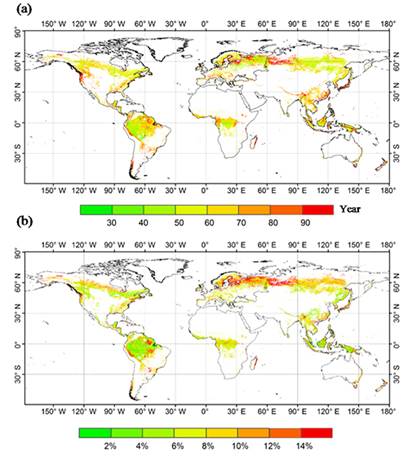科学家在全球森林碳滞留时间研究中取得进展

森林碳滞留时间是表征森林生态系统生长与死亡平衡的一个生物物理量,等同于地上生物量与地上净生产力的比值,反映了碳在生态系统的滞留时间。这一变量直接决定了森林碳库的大小,同时也是很多动态植被模型的重要参数。但由于数据的缺乏,目前在全球尺度上对森林碳滞留时间的研究较少。因此,分析森林碳滞留时间,对于了解森林生态系统碳库变化、减小碳库或地上生物量模拟的不确定性,具有重要科学意义。
中国科学院植物研究所郭庆华研究组基于已发表文献数据,整合分析全球尺度上不同森林植被功能型1319个样点的森林碳滞留时间,分析其生物和非生物影响因素,并以动态植被模型Integrated Biosphere Simulator(IBIS)为例探讨如何改进提高这一参数对全球森林地上生物量模拟精度。分析发现,不同森林植被功能型的碳滞留时间差别较大,温带落叶阔叶林与寒带针叶林森林碳滞留时间较长,而暖温带森林较短。统计表明,在全球尺度上,气温和降水对不同植被功能型的影响不同,碳滞留时间与气温存在正相关关系,而与降水存在负相关关系;两者与林龄可以作为碳滞留时间很好的预测因子。随后,研究人员结合其他光学遥感数据,利用随机森林方法估算了全球尺度的碳滞留时间,发现不同森林植被功能型的碳滞留时间在全球范围内呈现出很大的空间异质性。为进一步验证全球森林碳库对碳滞留时间的敏感性,研究组利用IBIS模拟RCP4.5情景模式下未来一百年(2000-2100年)森林地上生物量的变化,发现不同参数化方案模拟的森林地上生物量在2100年变化幅度较大,其中利用改进的碳滞留时间得到的生物量最大,而利用缺省参数时模型得到的生物量最小。
这一研究成果揭示了全球森林碳滞留时间的变化机制,对改进动态植被模型参数不确定性具有重要科学意义。
该研究成果近期在线发表在国际学术期刊Global Biogeochemical Cycles上。郭庆华研究组助理研究员薛宝林为论文第一作者,郭庆华为通讯作者。该研究得到了国家自然科学基金和国家基础研究计划的资助。(来源:科学网)
Global patterns of woody residence time and its influence on model simulation of aboveground biomass
Abstract Woody residence time (τw) is an important parameter that expresses the balance between mature forest recruitment/growth and mortality. Using field data collected from the literature, this study explored the global forest τw and investigated its influence on model simulations of aboveground biomass (AGB) at a global scale. Specifically, τw was found to be related to forest age, annual temperature, and precipitation at a global scale, but its determinants were different among various plant function types. The estimated global forest τw based on the filed data showed large spatial heterogeneity, which plays an important role in model simulation of AGB by a dynamic global vegetation model (DGVM). The τw could change the resulting AGB in tenfold based on a site-level test using the Monte Carlo method. At the global level, different parameterization schemes of the Integrated Biosphere Simulator using the estimated τw resulted in a twofold change in the AGB simulation for 2100. Our results highlight the influences of various biotic and abiotic variables on forest τw. The estimation of τw in our study may help improve the model simulations and reduce the parameter\&\#39\;s uncertainty over the projection of future AGB in the current DGVM or Earth System Models. A clearer understanding of the responses of τw to climate change and the corresponding sophisticated description of forest growth/mortality in model structure is also needed for the improvement of carbon stock prediction in future studies.
原文链接:http://onlinelibrary.wiley.com/doi/10.1002/2016GB005557/pdf

